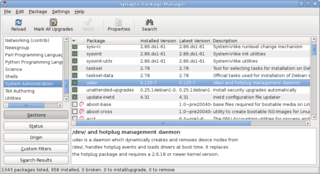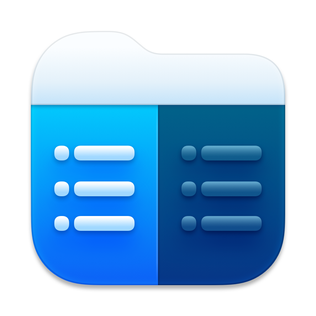Related Research Articles
A file viewer is utility application software on operating systems for example; Windows, MacOS and Linux, that handle the access of files that are located on data storage devices to be accessible by the user. File viewing utility software allows the user to open and read content on a Personal Computer (PC) or on a Mobile phone.

An operating system (OS) is system software that manages computer hardware and software resources, and provides common services for computer programs.

A package manager or package-management system is a collection of software tools that automates the process of installing, upgrading, configuring, and removing computer programs for a computer in a consistent manner.

A terminal emulator, or terminal application, is a computer program that emulates a video terminal within some other display architecture. Though typically synonymous with a shell or text terminal, the term terminal covers all remote terminals, including graphical interfaces. A terminal emulator inside a graphical user interface is often called a terminal window.
In computing, cross-platform software is computer software that is designed to work in several computing platforms. Some cross-platform software requires a separate build for each platform, but some can be directly run on any platform without special preparation, being written in an interpreted language or compiled to portable bytecode for which the interpreters or run-time packages are common or standard components of all supported platforms.

Extensible Messaging and Presence Protocol is an open communication protocol designed for instant messaging (IM), presence information, and contact list maintenance. Based on XML, it enables the near-real-time exchange of structured data between two or more network entities. Designed to be extensible, the protocol offers a multitude of applications beyond traditional IM in the broader realm of message-oriented middleware, including signalling for VoIP, video, file transfer, gaming and other uses.

Network-attached storage (NAS) is a file-level computer data storage server connected to a computer network providing data access to a heterogeneous group of clients. The term "NAS" can refer to both the technology and systems involved, or a specialized device built for such functionality.

Embedded software is computer software, written to control machines or devices that are not typically thought of as computers, commonly known as embedded systems. It is typically specialized for the particular hardware that it runs on and has time and memory constraints. This term is sometimes used interchangeably with firmware.

Privilege escalation is the act of exploiting a bug, a design flaw, or a configuration oversight in an operating system or software application to gain elevated access to resources that are normally protected from an application or user. The result is that an application with more privileges than intended by the application developer or system administrator can perform unauthorized actions.
Picture Transfer Protocol (PTP) is a protocol originally developed by the Photographic and Imaging Manufacturers Association (PIMA) to allow the transfer of images from digital cameras to computers and other peripheral devices without the need for additional device drivers. The protocol was standardized by the ISO in 2005. The current version of the standard is ISO 15740:2013.
In the context of free and open-source software, proprietary software only available as a binary executable is referred to as a blob or binary blob. The term usually refers to a device driver module loaded into the kernel of an open-source operating system, and is sometimes also applied to code running outside the kernel, such as system firmware images, microcode updates, or userland programs. The term blob was first used in database management systems to describe a collection of binary data stored as a single entity.

A computer appliance is a computer system with a combination of hardware, software, or firmware that is specifically designed to provide a particular computing resource. Such devices became known as appliances because of the similarity in role or management to a home appliance, which are generally closed and sealed, and are not serviceable by the user or owner. The hardware and software are delivered as an integrated product and may even be pre-configured before delivery to a customer, to provide a turn-key solution for a particular application. Unlike general purpose computers, appliances are generally not designed to allow the customers to change the software and the underlying operating system, or to flexibly reconfigure the hardware.
In computing, virtualization or virtualisation is the act of creating a virtual version of something at the same abstraction level, including virtual computer hardware platforms, storage devices, and computer network resources.

collectd is a Unix daemon that collects, transfers and stores performance data of computers and network equipment. The acquired data is meant to help system administrators maintain an overview over available resources to detect existing or looming bottlenecks.

Ubuntu One is an OpenID-based single sign-on service operated by Canonical Ltd. to allow users to log onto many Canonical-owned Web sites. Until April 2014, Ubuntu One was also a file hosting service and music store that allowed users to store data "in the cloud".
Object storage is a computer data storage approach that manages data as "blobs" or "objects", as opposed to other storage architectures like file systems which manages data as a file hierarchy, and block storage which manages data as blocks within sectors and tracks. Each object is typically associated with a variable amount of metadata, and a globally unique identifier. Object storage can be implemented at multiple levels, including the device level, the system level, and the interface level. In each case, object storage seeks to enable capabilities not addressed by other storage architectures, like interfaces that are directly programmable by the application, a namespace that can span multiple instances of physical hardware, and data-management functions like data replication and data distribution at object-level granularity.

Distributed Data Management Architecture (DDM) is IBM's open, published software architecture for creating, managing and accessing data on a remote computer. DDM was initially designed to support record-oriented files; it was extended to support hierarchical directories, stream-oriented files, queues, and system command processing; it was further extended to be the base of IBM's Distributed Relational Database Architecture (DRDA); and finally, it was extended to support data description and conversion. Defined in the period from 1980 to 1993, DDM specifies necessary components, messages, and protocols, all based on the principles of object-orientation. DDM is not, in itself, a piece of software; the implementation of DDM takes the form of client and server products. As an open architecture, products can implement subsets of DDM architecture and products can extend DDM to meet additional requirements. Taken together, DDM products implement a distributed file system.

Commander One is a dual-pane file manager designed for macOS. Developed by Electronic Team, Inc. the app is created entirely in Swift and aims to provide users with a powerful and intuitive tool to navigate, manage, and manipulate files and folders on their Mac computers. The application offers a wide range of features and meets the requirements of both casual users and professionals.
References
- ↑ "StorageManager". Android Developers.